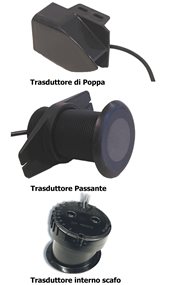The fishfinder needs its own transducer to operate, which sends the ultrasonic signal to the bottom and receives it, then sends it back to the fishfinder in the form of an electrical impulse.
Transducers are distinguished by their installation mode:
- Aft, is by far the most common because it represents the best compromise between economy, ease of installation and performance. In fact, the installation is simple (just fix it with 4 screws), but the stern area is one of the parts of the hull most subject to turbulence
- Passante, is able to give the absolute best performance, but you are forced to make a hole in the hull with the consequent weakening of the structure and risk of sinking in case of impact.
- Inside the hull, no holes should be drilled and the transducer will not be subject to fouling, but the sensitivity is reduced (commonly by 10%). It must be immersed in a container filled with water or vaseline and then sealed. It's an option only available for fiberglass hulls.
They are also distinguished by the material in which they are composed, all suitable for fiberglass hulls:
- Plastic, is the most economical and most widespread solution. Not suitable for wooden hulls.
- Bronze, is diffused for the passing model, in such case suggested because it is more resistant. In the case of wooden hulls is the one that best suits.
- Steel, it is recommended for aluminium or steel hulls
